Bergamo is a city in Lombardy, a region of Italy, and the capital of the namesake province. One of the most scenic cities in Italy, it is located on and around a steep hill, green in the summer and white in the winter, complemented by pastel-coloured architecture, against the backdrop of nearby Alps. Its appeal to tourists is enhanced by the nearby Orio al Serio airport. Looking at its beauty, it is hard to believe Bergamo is also one of Italy's most industrialized cities, from which it derives its relative wealth.
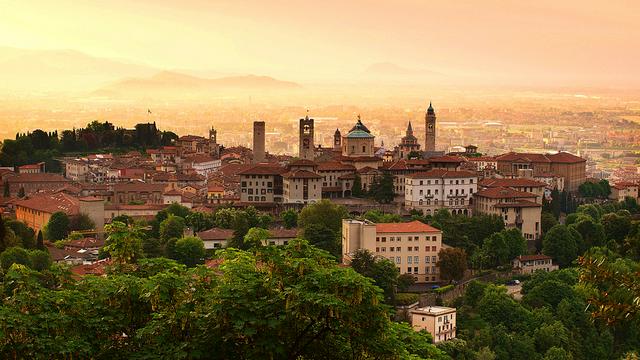
Bergamo is a pretty town of some 120,000 people nestling in the foothills of the Alps. Widely acclaimed as a city of rare beauty, Bergamo is famous for its wealth of artistic treasures and enchanting medieval atmosphere. It is a real life tale of two cities: Città Bassa, the busy and modern lower city, and Città Alta, the upper city with its rich heritage of art and history.
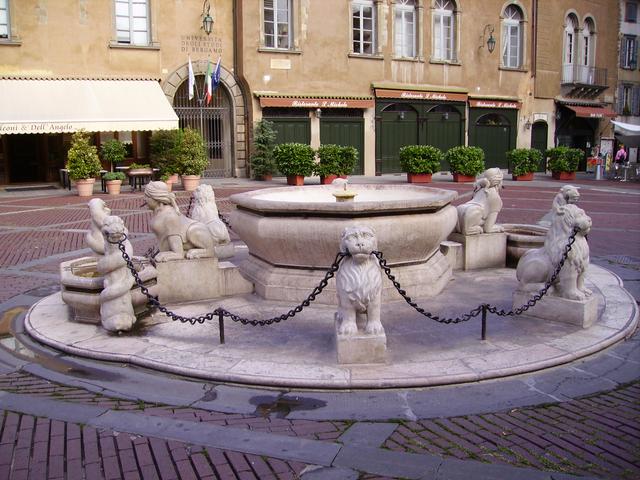
- Piazza Vecchia. The heart of the old town, displaying a mix of medieval and Renaissance architecture: Palazzo della Ragione, Torre del Comune, Palazzo Nuovo and Contarini Fountain.
- Bergamo Cathedral. The surviving one of the two cathedrals once existing in the city, dedicated to Saint Alexander of Bergamo. Incidentally, this cathedral was originally devoted to Saint Vincent, but once the original Saint Alexander cathedral was torn down by the Venetians, the dioceses were merged under Saint Alexander's name. The cathedral has a classic Latin Cross layout, and has seen many renovations and refurbishments, the latest being the addition of the 19th century neoclassical facade.
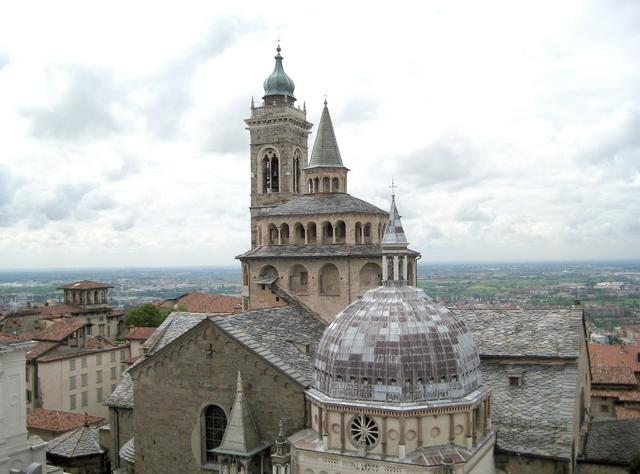
- Santa Maria Maggiore. A 12th century church with later alterations.
- Colleoni Chapel. It is a church and mausoleum built in the 15th century with richly decorated polychrome marble façade.
- Torre di Gombito. A tower-house, built around 1100
- Rocca. A walled stronghold which houses a museum.
- Piazza Mercato delle Scarpe.
- Chiesa di Sant'Andrea. With Madonna Enthroned with Saints by Moretto da Brescia.
- Chiesa di San Michele al Pozzo Bianco. Founded in the 8th century, much of it's interior belongs 1400s with frescoes in Byzantine style. There are also some frescos of 16th century by Lorenzo Lotto, Giovan Battista Guarinoni d'Averara and painting Madonna and child with Saints Peter and Paul by Giovanni Paolo Lolmo.
- Palazzo Medolago Albani. It was built between 1783 and 1791 in neoclassical style — a typical example of bourgeois palace of the late 18th century.
- Archeological Museum.
- Science Museum.
- Donizetti Museum, Via Arena 9. Devoted to one of Bergamo's most famous sons, the composer Gaetano Donizetti.
- Museo Storico della Citta. A former convent now housing the museum of the history of the city of Bergamo
- San Vigilio. A small hilltop village that can be reached on foot or by a second funicolare from Città Alta. It offers walks with spectacular views, and a ruined castle. Entry into the castle is free, and is part of a public park. Climb all the way to the top of the castle for more views.
The upper town is surrounded by world heritage listed stone walls, built in the 16th century by the Venetians, which survive to a large extent to this day. The four gates that led through the walls to the city do survive as well.
- Porta Sant'Agostino.
- Porta Sant'Allessandro.
- Porta San Giacomo.
- Porta San Lorenzo.
Porta Sant'Agostino.
Porta Sant'Allessandro.
Porta San Giacomo.
Porta San Lorenzo.
Piazza Vecchia. The heart of the old town, displaying a mix of medieval and Renaissance architecture: Palazzo della Ragione, Torre del Comune, Palazzo Nuovo and Contarini Fountain.
Bergamo Cathedral. The surviving one of the two cathedrals once existing in the city, dedicated to Saint Alexander of Bergamo. Incidentally, this cathedral was originally devoted to Saint Vincent, but once the original Saint Alexander cathedral was torn down by the Venetians, the dioceses were merged under Saint Alexander's name. The cathedral has a classic Latin Cross layout, and has seen many renovations and refurbishments, the latest being the addition of the 19th century neoclassical facade.
Santa Maria Maggiore. A 12th century church with later alterations.
Colleoni Chapel. It is a church and mausoleum built in the 15th century with richly decorated polychrome marble façade.
Torre di Gombito. A tower-house, built around 1100
Rocca. A walled stronghold which houses a museum.
Piazza Mercato delle Scarpe.
Chiesa di Sant'Andrea. With Madonna Enthroned with Saints by [[w:Moretto_da_Brescia|Moretto da Brescia]].
Chiesa di San Michele al Pozzo Bianco. Founded in the 8th century, much of it's interior belongs 1400s with frescoes in Byzantine style. There are also some frescos of 16th century by Lorenzo Lotto, Giovan Battista Guarinoni d'Averara and painting Madonna and child with Saints Peter and Paul by Giovanni Paolo Lolmo.
Palazzo Medolago Albani. It was built between 1783 and 1791 in neoclassical style — a typical example of bourgeois palace of the late 18th century.
Archeological Museum.
Science Museum.
Donizetti Museum, Via Arena 9. Devoted to one of Bergamo's most famous sons, the composer Gaetano Donizetti.
Museo Storico della Citta. A former convent now housing the museum of the history of the city of Bergamo
San Vigilio. A small hilltop village that can be reached on foot or by a second funicolare from Città Alta. It offers walks with spectacular views, and a ruined castle. Entry into the castle is free, and is part of a public park. Climb all the way to the top of the castle for more views.
- Accademia Carrara. One of Northern Italy's most important collections of medieval, Renaissance and Baroque paintings.
- GAMeC. The city's gallery of modern and contemporary art, which usually hosts several interesting exhibitions.
- Piazza Vittorio Veneto.
- Santa Maria delle Grazie.
- Santi Bartolomeo e Stefano. Baroque church built in the 17th century adjacent to the convent of the same name. Its interior has had many lush decorations added in the 18th century, as well as the chorus of the former church of San Stefano, which itself was torn down in the same period and by way of that merged into one parish.
Accademia Carrara. One of Northern Italy's most important collections of medieval, Renaissance and Baroque paintings.
GAMeC. The city's gallery of modern and contemporary art, which usually hosts several interesting exhibitions.
Piazza Vittorio Veneto.
Santa Maria delle Grazie.
Santi Bartolomeo e Stefano. Baroque church built in the 17th century adjacent to the convent of the same name. Its interior has had many lush decorations added in the 18th century, as well as the chorus of the former church of San Stefano, which itself was torn down in the same period and by way of that merged into one parish.
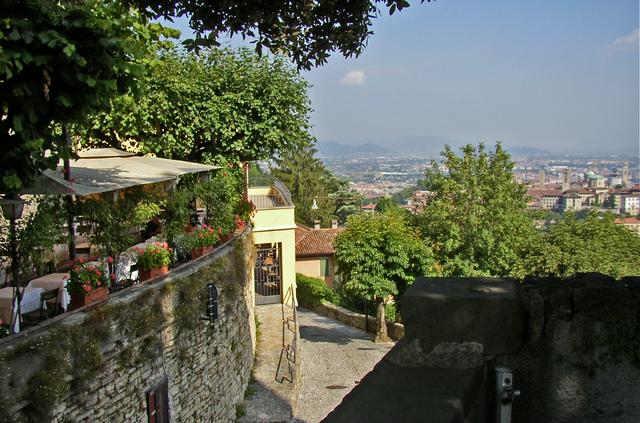
- Teatro Donizetti.
- Teatro Sociale.
- Stadio Atleti Azzurri d’Italia.
- Ride a mountain bike in the beautiful Parco dei Colli just behind the old town. You will feel as if you are riding in the mountains.
- Watch football (ie soccer) at Atalanta BC. They play in Serie A, the top tier of Italian football. Their home ground is the Gewiss Stadium, capacity 21,300, two km north of the railway station.
- The Bergamo Lions are an American Football team that used to be among the best in Europe in the late 1990s and early 2000s. They are featured in the John Grisham book "playing for pizza" and do in reality also feature American players who get paid, while the bulk of the team literally or figuratively plays for pizza.
Teatro Donizetti.
Teatro Sociale.
Stadio Atleti Azzurri d’Italia.
Ride a mountain bike in the beautiful Parco dei Colli just behind the old town. You will feel as if you are riding in the mountains.
Watch football (ie soccer) at Atalanta BC. They play in Serie A, the top tier of Italian football. Their home ground is the Gewiss Stadium, capacity 21,300, two km north of the railway station.
- Cafe della Funicolare, Via Porta Dipinta, 1 (In the city Alta Funicolare station.. For snacks, a drink or simply the great view.
- Da Franco Ristorante Pizzeria, Via Colleoni 8, +39 035238565. Closed Mondays. Try it for lunch or an evening meal.
- Da Mimmo, Via Colleoni 17, +39 035 218535. Closed Tuesdays. More than just a pizzeria. Indeed ! Worth a visit for the quality of food and service.
- Il Sole, Via Colleoni 1 (on the corner of Piazza Vecchia and Via Colleoni..
- Antica Trattoria dei tre Gobbi, 20 Via Broseta. A very good place to eat.
- La Bruschetta. A good value restaurant/pizzeria in the cellar of a building and worth a mention.
- La Ciotola, Viale Papa Giovanni XXlll, 86 (in the Citta Bassa area. A good restaurant/pizzeria near the Mercure hotel.
- Giopi e Margi, Via Borgo Palazzo 27 (in the residential area just a short walk from city center. Traditional restaurant serving lomabrdy cuisine is worth a visit if you fancy having an Italian meal not just pizza and pasta. Family run business is a well kept secret between locals.
Cafe della Funicolare, Via Porta Dipinta, 1 (In the city Alta Funicolare station.. For snacks, a drink or simply the great view.
Da Franco Ristorante Pizzeria, Via Colleoni 8, +39 035238565. Closed Mondays. Try it for lunch or an evening meal.
Da Mimmo, Via Colleoni 17, +39 035 218535. Closed Tuesdays. More than just a pizzeria. Indeed ! Worth a visit for the quality of food and service.
Il Sole, Via Colleoni 1 (on the corner of Piazza Vecchia and Via Colleoni..
Antica Trattoria dei tre Gobbi, 20 Via Broseta. A very good place to eat.
La Bruschetta. A good value restaurant/pizzeria in the cellar of a building and worth a mention.
La Ciotola, Viale Papa Giovanni XXlll, 86 (in the Citta Bassa area. A good restaurant/pizzeria near the Mercure hotel.
Giopi e Margi, Via Borgo Palazzo 27 (in the residential area just a short walk from city center. Traditional restaurant serving lomabrdy cuisine is worth a visit if you fancy having an Italian meal not just pizza and pasta. Family run business is a well kept secret between locals.
- Il Circolino. Locals here play bocce and drink lanterna (a huge drink made of white wine and campari rosso).
- Bobino, piazza della Liberta. 7AM-02AM daily, except Sundays. is a cool bar/restaurant with a long wine & cocktail list (including Champagne).
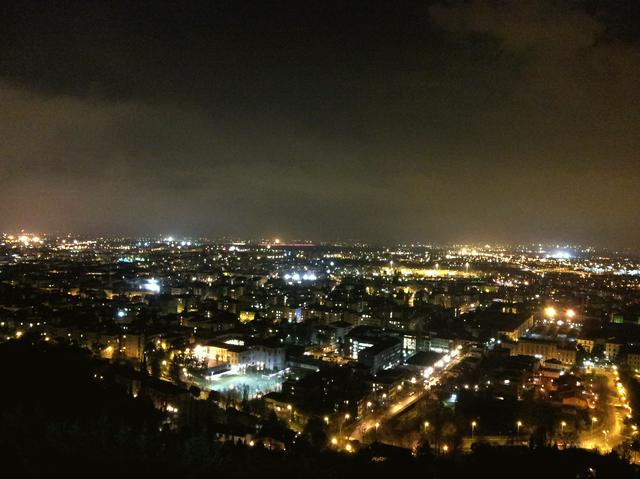
Il Circolino. Locals here play bocce and drink lanterna (a huge drink made of white wine and campari rosso).
Bobino, piazza della Liberta. 7AM-02AM daily, except Sundays. is a cool bar/restaurant with a long wine & cocktail list (including Champagne).
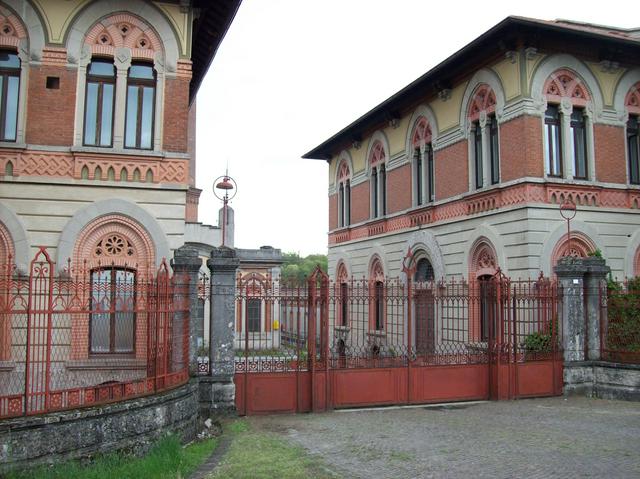
- Crespi d'Adda. It is a planned industrial village between Bergamo and Milan. It has been nominated to the UNESCO World Heritage List
- The Bergamo area is in the foothills of the Alps, and has a handful of Ski resorts within a one-hour drive. Notable is the Brembana Valley which contains the resorts of Foppolo, Carona and San Simone.
- Lake Endine — Glorious natural scenery which ranges from lakes to woods, from high mountaintops to spectacular hills. The well-preserved environment offers a wide range of sporting activities: trekking, mountain climbing, canyoning, mountain biking, canoeing, sailing. The area has a temperate to warm climate without no summer aridity and is only slightly dry in winter. It isn't too hot in summer and the winters aren't too harsh, fog is practically unheard of and there are many cloudless days.
- Lake Iseo, one of the smallest and less touristy among the Northern Italian lakes. Go by bus from the Bergamo bus station (opposite the train station) to Tavernola. Then take a ferry to Montisola.
- Como (one of the main cities at the shores of beautiful Lake Como is also accessible by train, but requires almost travelling back to Milan (you change at Monza). It is worth visiting from Bergamo and vice versa. The journey takes between one and a half and two hours.
- Stezzano At only 6 km from Bergamo, it is perfect for those who may want to visit Bergamo but stay in a more rural and peaceful setting. The town is well-equipped with nice cafes, two pizzerie, shops, two gelaterie and a bank.
Crespi d'Adda. It is a planned industrial village between Bergamo and Milan. It has been nominated to the [[UNESCO World Heritage List#Italy|UNESCO World Heritage List]]
The Bergamo area is in the foothills of the Alps, and has a handful of Ski resorts within a one-hour drive. Notable is the Brembana Valley which contains the resorts of [[Foppolo]], [[Carona]] and [[San Simone]].
[[Lake Endine]] — Glorious natural scenery which ranges from lakes to woods, from high mountaintops to spectacular hills. The well-preserved environment offers a wide range of sporting activities: trekking, mountain climbing, canyoning, mountain biking, canoeing, sailing. The area has a temperate to warm climate without no summer aridity and is only slightly dry in winter. It isn't too hot in summer and the winters aren't too harsh, fog is practically unheard of and there are many cloudless days.
[[Lake Iseo]], one of the smallest and less touristy among the Northern Italian lakes. Go by bus from the Bergamo bus station (opposite the train station) to Tavernola. Then take a ferry to Montisola.
Stezzano At only 6 km from Bergamo, it is perfect for those who may want to visit Bergamo but stay in a more rural and peaceful setting. The town is well-equipped with nice cafes, two pizzerie, shops, two gelaterie and a bank.
